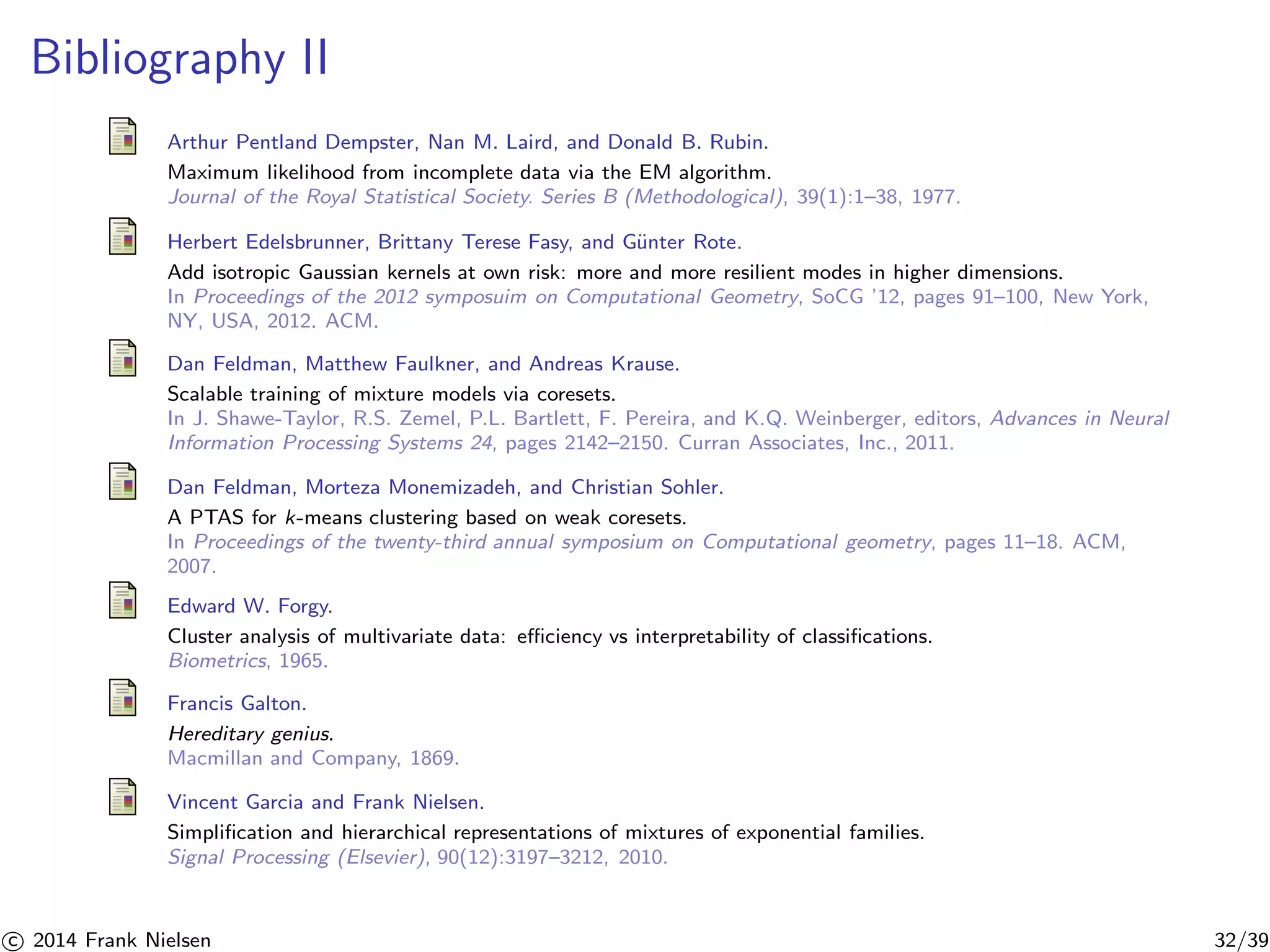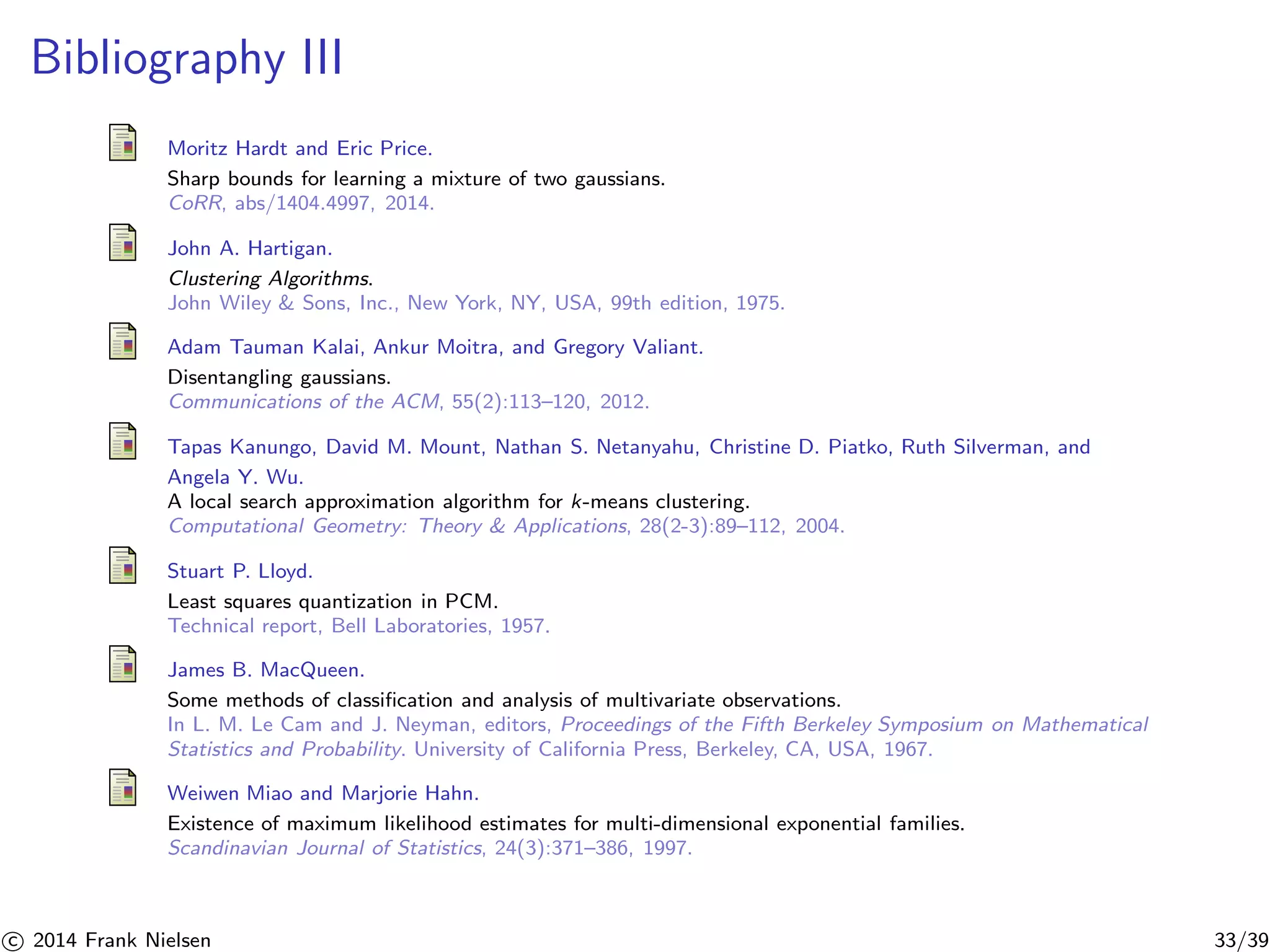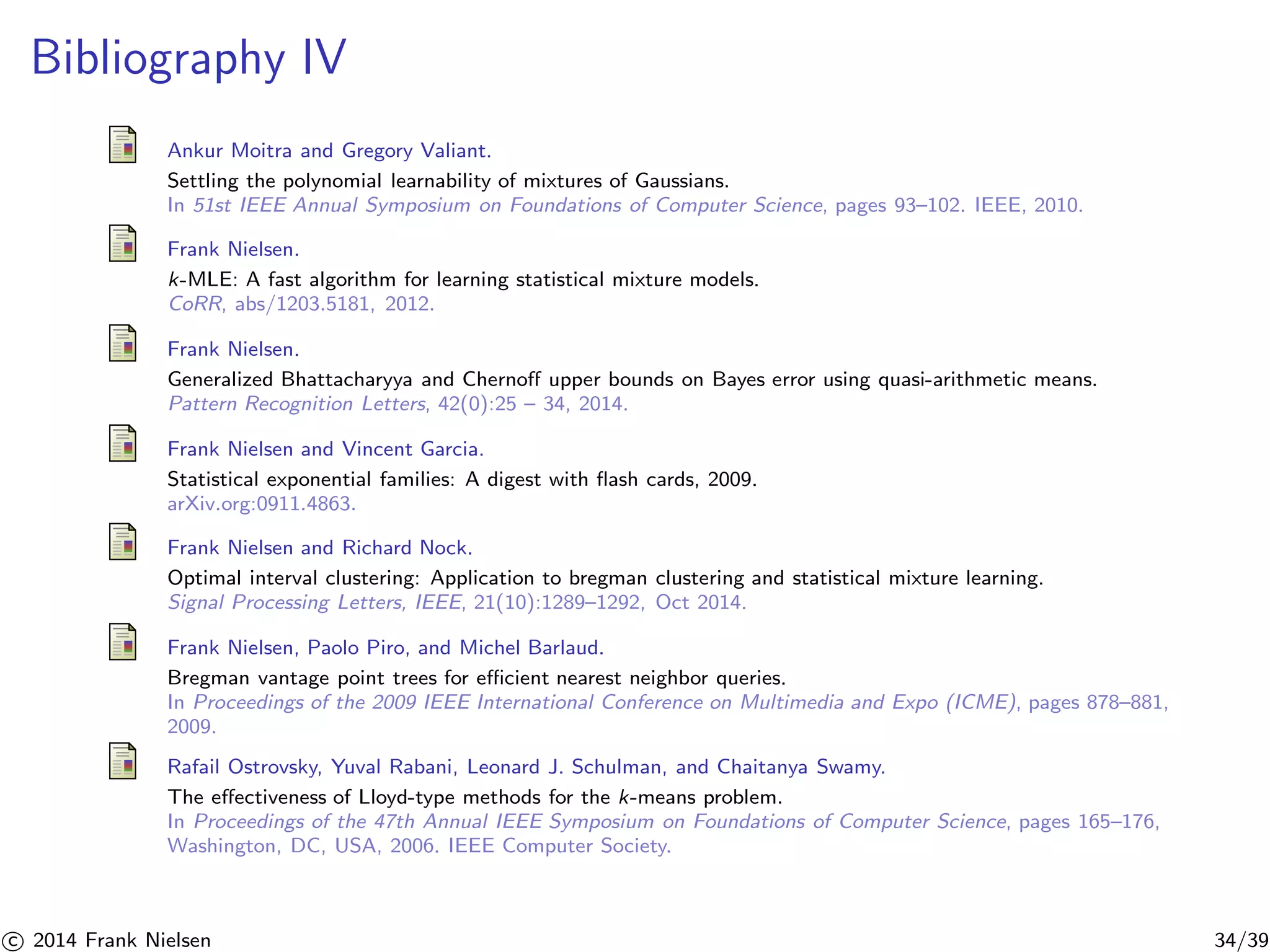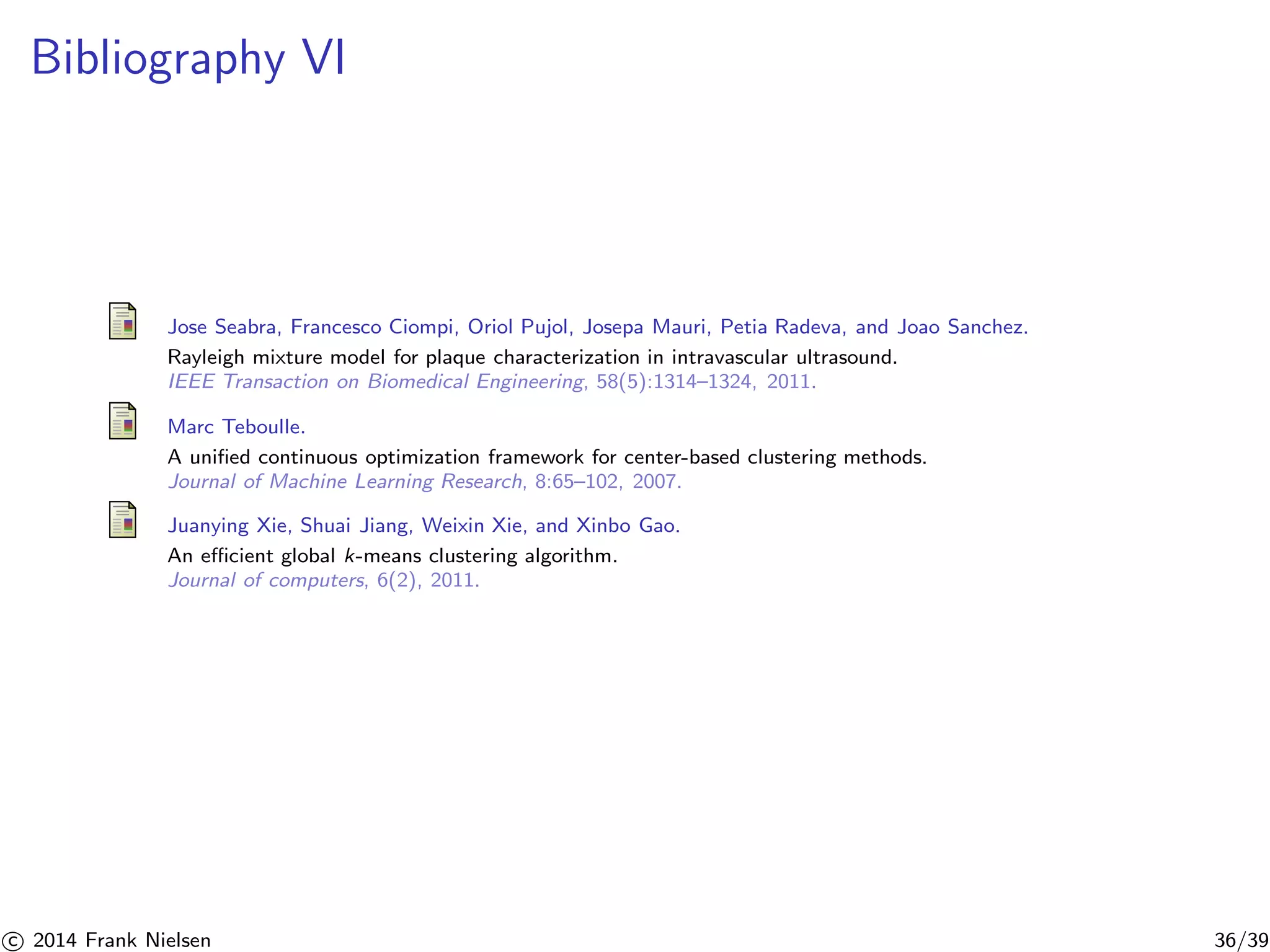The document discusses the k-mle methodology for learning statistical mixtures, focusing on maximizing complete likelihood through geometric hard clustering. It highlights the process of estimating parameters from mixture models, identifies challenges in mixture inference, and outlines the k-mle algorithm's steps, including initialization and convergence testing. Applications to exponential families and comparisons with traditional methods like expectation-maximization (EM) are also presented.
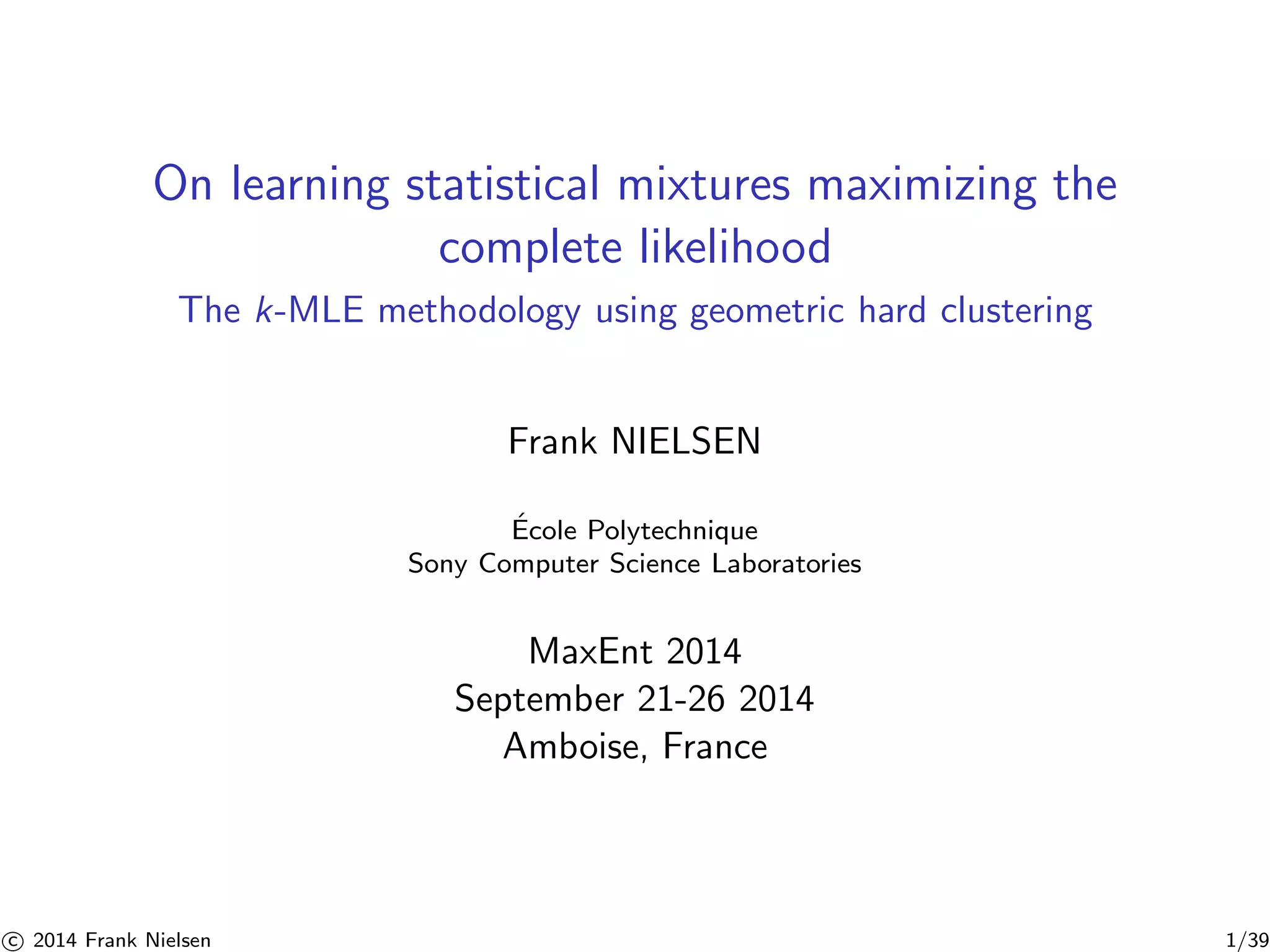
![Finite mixtures: Semi-parametric statistical models
◮ Mixture M ∼ MM(W, ) with density m(x) =
Xk
i=1
wip(x|λi )
not sum of RVs!. = {λi}i , W = {wi }i
◮ Multimodal, universally modeling smooth densities
◮ Gaussian MMs with support X = R, Gamma MMs with
support X = R+ (modeling distances [34])
◮ Pioneered by Karl Pearson [29] (1894). precursors: Francis
Galton [13] (1869), Adolphe Quetelet [31] (1846), etc.
◮ Capture sub-populations within an overall population
(k = 2, crab data [29] in Pearson)
c 2014 Frank Nielsen 2/39](https://image.slidesharecdn.com/slides-kmle-maxent2014-140917112600-phpapp02/75/On-learning-statistical-mixtures-maximizing-the-complete-likelihood-2-2048.jpg)
![Example of k = 2-component mixture [17]
Sub-populations (k = 2) within an overall population...
Sub-species in species, etc.
Truncated distributions (what is the support! black swans ?!)
c 2014 Frank Nielsen 3/39](https://image.slidesharecdn.com/slides-kmle-maxent2014-140917112600-phpapp02/75/On-learning-statistical-mixtures-maximizing-the-complete-likelihood-3-2048.jpg)
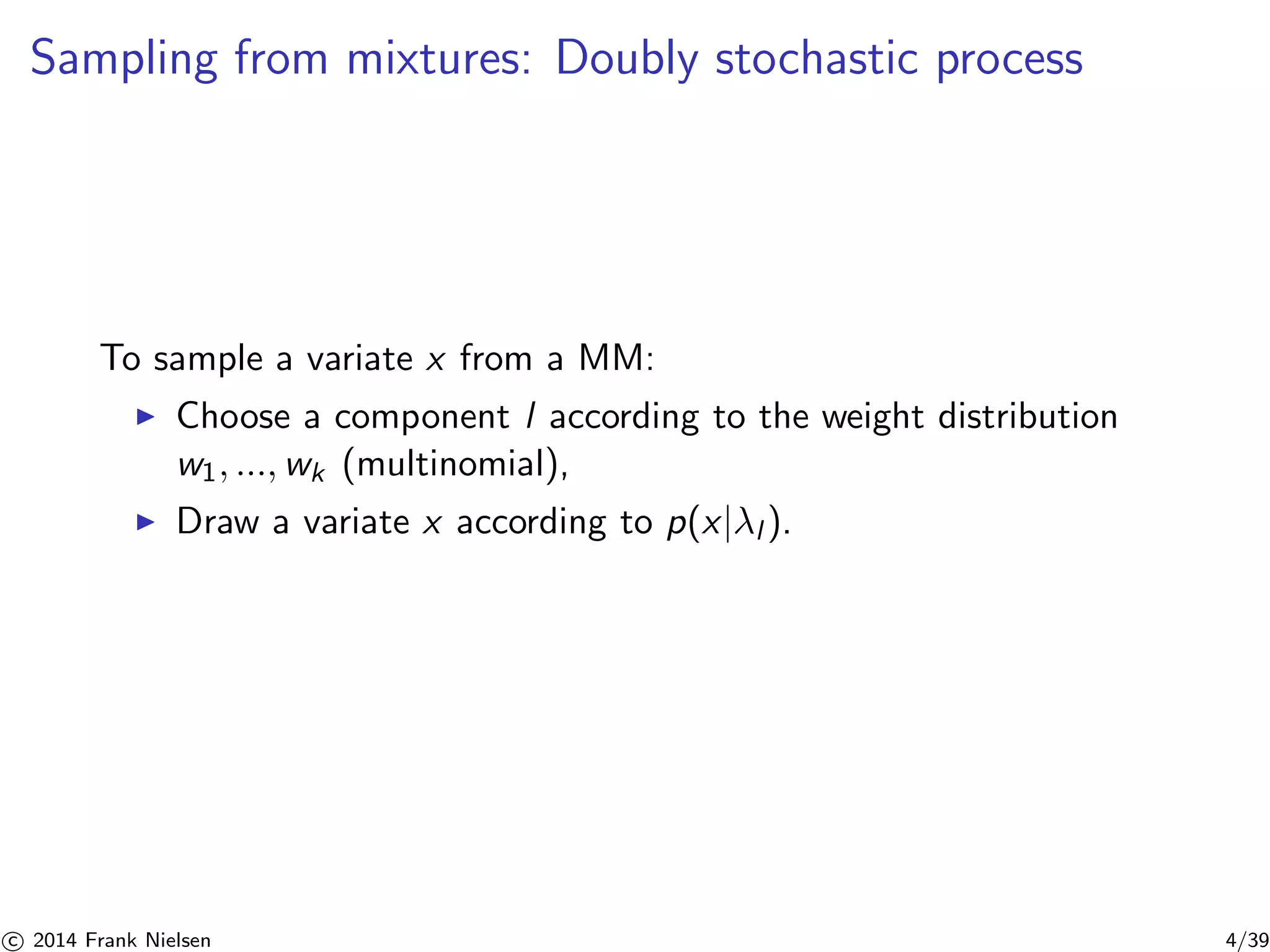
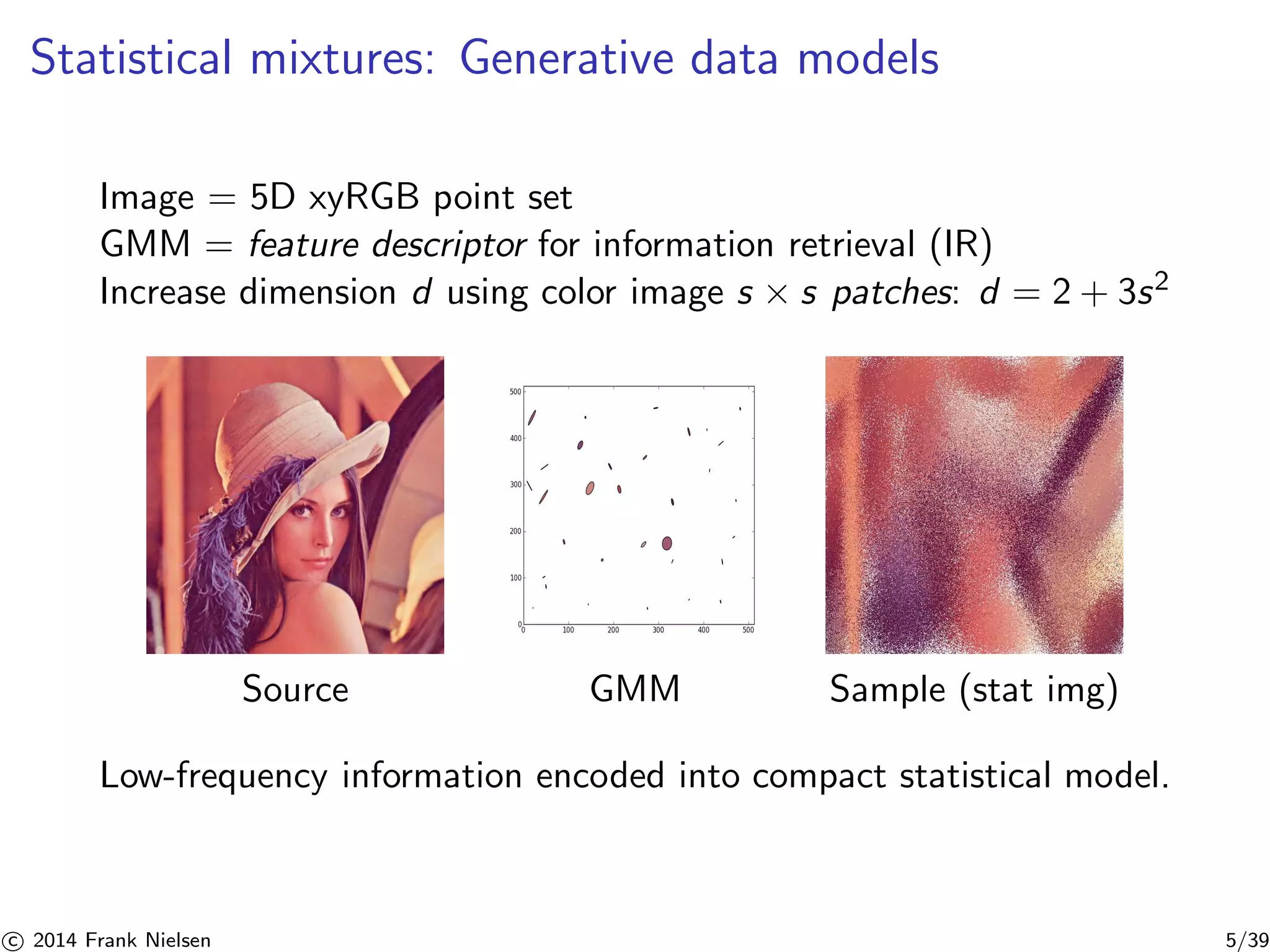

![Mixture inference: Incomplete versus complete likelihood
◮ Sub-populations within an overall population: observed data
xi does not include the subpopulation label li
◮ k = 2: Classification and Bayes error (upper bounded by
Chernoff information [24])
◮ Inference: Assume IID, maximize (log)-likelihood:
◮ Complete using indicator variables zi ,j (for li : zi ,li = 1):
lc = log
Yn
i=1
Yk
j=1
(wjp(xi |θj ))zi,j =
X
i
X
j
zi ,j log(wjp(xi |θj ))
◮ Incomplete (hidden/latent variables) and log-sum
intractability:
li = log
Y
i
m(x|W, ) =
X
i
log
X
j
wjp(xi |θj )
c 2014 Frank Nielsen 7/39](https://image.slidesharecdn.com/slides-kmle-maxent2014-140917112600-phpapp02/75/On-learning-statistical-mixtures-maximizing-the-complete-likelihood-7-2048.jpg)
![Mixture learnability and inference algorithms
◮ Which criterion to maximize? incomplete or complete
likelihood? What kind of evaluation criteria?
◮ From Expectation-Maximization [8] (1977) to TCS methods:
Polynomial learnability of mixtures [22, 15] (2014), mixtures
and core-sets [10] for massive data sets, etc.
Some technicalities:
◮ Many local maxima of likelihood functions li and lc (EM
converges locally and needs a stopping criterion)
◮ Multimodal density (#modes k [9], ghost modes even for
isotropic GMMs)
◮ Identifiability (permutation of labels, parameter distinctness)
◮ Irregularity: Fisher information may be zero [6], convergence
speed of EM
◮ etc.
c 2014 Frank Nielsen 8/39](https://image.slidesharecdn.com/slides-kmle-maxent2014-140917112600-phpapp02/75/On-learning-statistical-mixtures-maximizing-the-complete-likelihood-8-2048.jpg)
![Learning MMs: A geometric hard clustering viewpoint
max
W,Λ
lc (W, ) = max
Λ
Xn
i=1
k
max
j=1
log(wjp(xi |θj ))
≡ min
W,Λ
X
i
min
j
(−log p(xi |θj ) − log wj )
= min
W,Λ
Xn
i=1
k
min
j=1
Dj (xi ) ,
where cj = (wj , θj ) (cluster prototype) and
Dj (xi ) = −log p(xi |θj ) − log wj are potential distance-like
functions.
◮ Maximizing the complete likelihood amounts to a geometric
hard clustering [37, 11] for fixed P
wj ’s (distance Dj (·) depends
on cluster prototypes cj ): minΛ
i minj Dj (xi ).
◮ Related to classification EM [5] (CEM), hard/truncated EM
◮ Solution of argmax lc to initialize li (optimized by EM)
c 2014 Frank Nielsen 9/39](https://image.slidesharecdn.com/slides-kmle-maxent2014-140917112600-phpapp02/75/On-learning-statistical-mixtures-maximizing-the-complete-likelihood-9-2048.jpg)
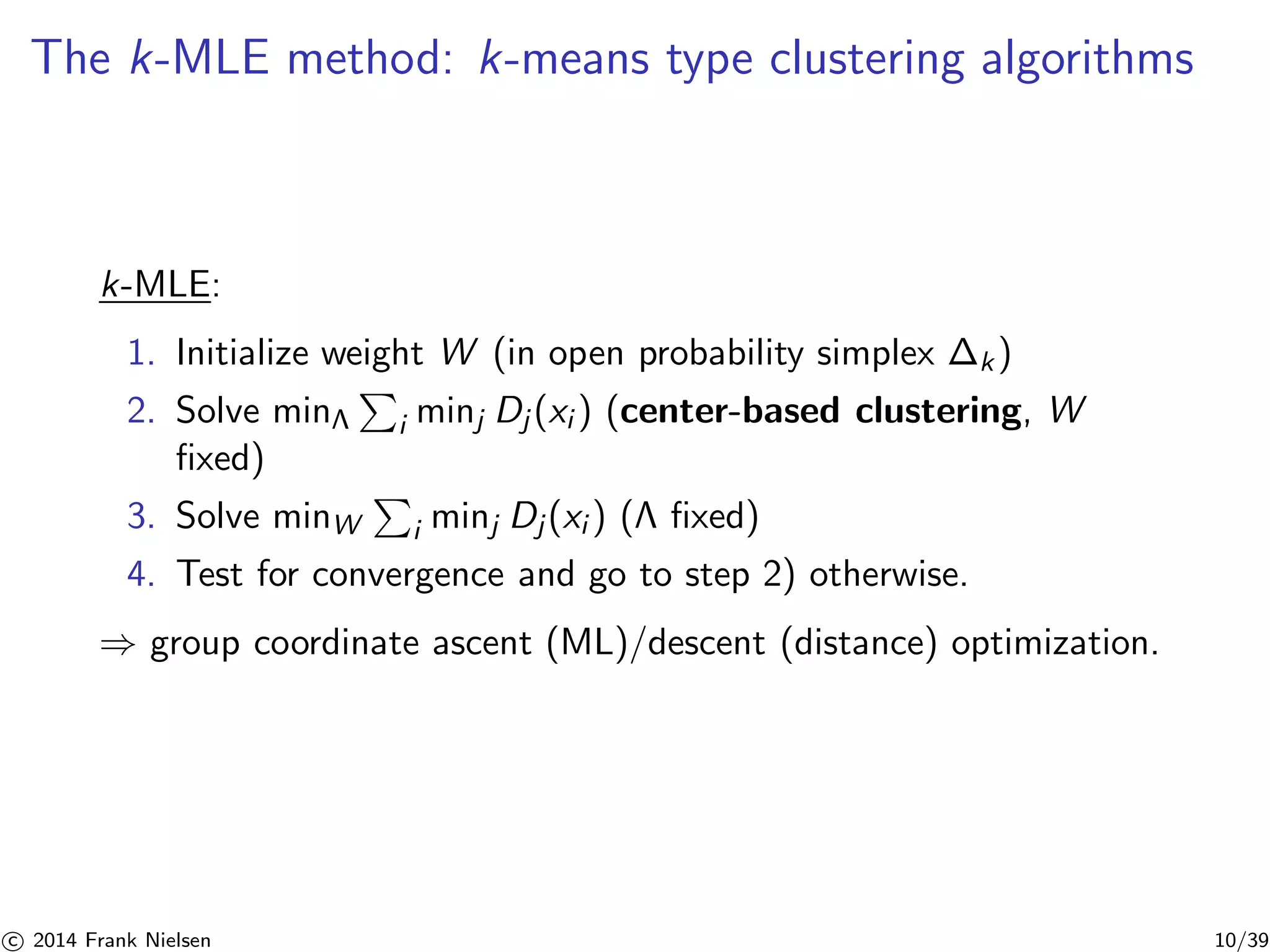
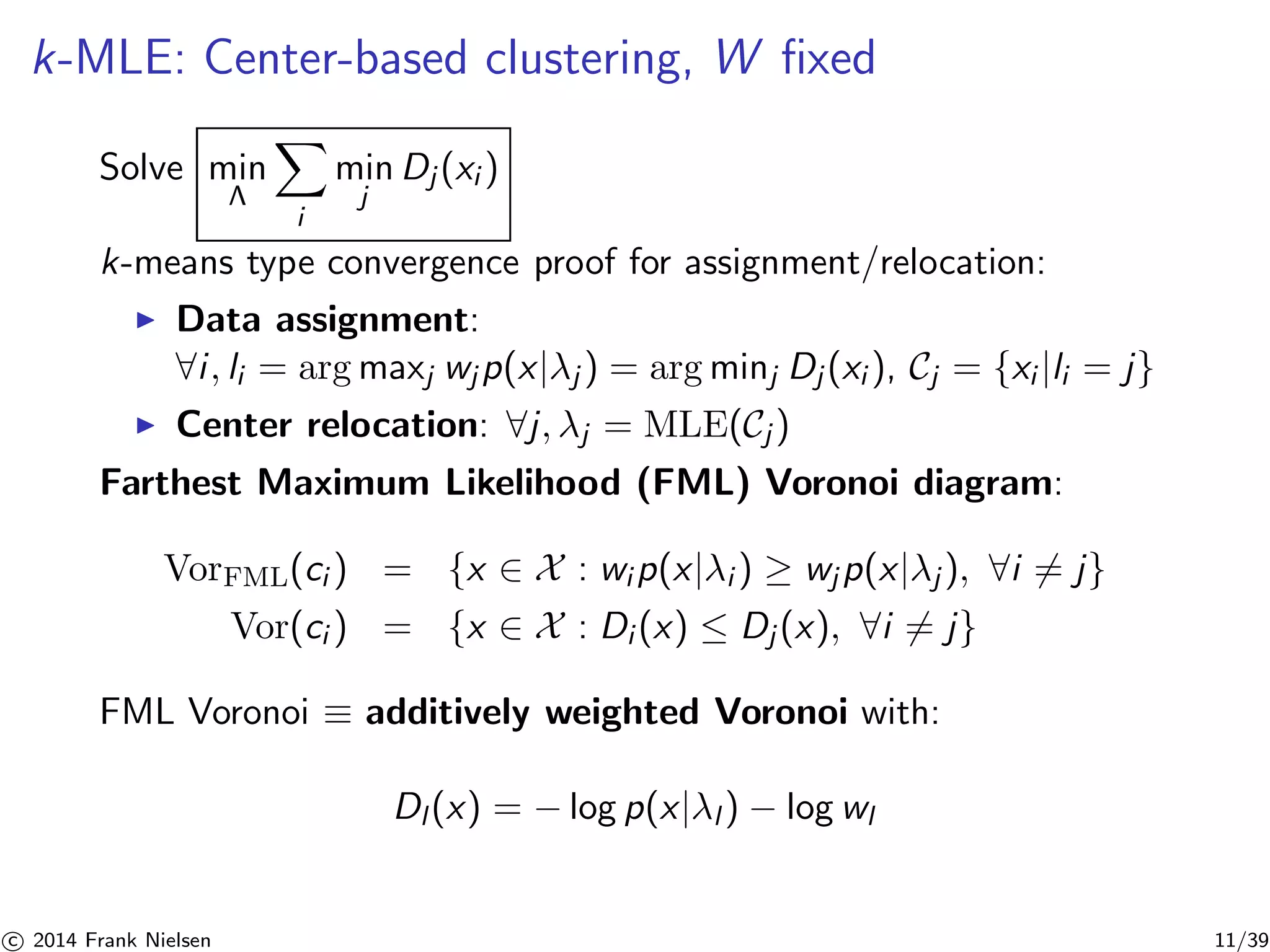
![k-MLE: Example for mixtures of exponential families
Exponential family:
Component density p(x|θ) = exp(t(x)⊤θ − F(θ) + k(x)) is
log-concave with:
◮ t(x): sufficient statistic in RD, D: family order.
◮ k(x): auxiliary carrier term (wrt Lebesgue/counting measure)
◮ F(θ): log-normalized, cumulant function, log-partition.
Dj (x) is convex: Clustering k-means wrt convex “distances”.
Farthest ML Voronoi ≡ additively-weighted Bregman Voronoi [4]:
−log p(x; θ) − log w = F(θ) − t(x)⊤θ − k(x) − log w
= BF∗(t(x) : η) + F∗(t(x)) + k(x) − log w
F∗(η) = max(θ⊤η − F(θ)): Legendre-Fenchel convex conjugate
c 2014 Frank Nielsen 12/39](https://image.slidesharecdn.com/slides-kmle-maxent2014-140917112600-phpapp02/75/On-learning-statistical-mixtures-maximizing-the-complete-likelihood-12-2048.jpg)
![Exponential families: Rayleigh distributions [36, 25]
Application: IntraVascular UltraSound (IVUS) imaging:
Rayleigh distribution:
p(x; λ) = x
2 e− x2
22
x ∈ R+ = X
d = 1 (univariate)
D = 1 (order 1)
θ = − 1
22
= (−∞, 0)
F(θ) = −log(−2θ)
t(x) = x2
k(x) = log x
(Weibull for k = 2)
Coronary plaques: fibrotic tissues, calcified tissues, lipidic tissues
Rayleigh Mixture Models (RMMs):
for segmentation and classification tasks
c 2014 Frank Nielsen 13/39](https://image.slidesharecdn.com/slides-kmle-maxent2014-140917112600-phpapp02/75/On-learning-statistical-mixtures-maximizing-the-complete-likelihood-13-2048.jpg)
![Exponential families: Multivariate Gaussians [14, 25]
Gaussian Mixture Models (GMMs).
(Color image interpreted as a 5D xyRGB point set)
Gaussian distribution p(x; μ,):
1
(2)
d
2√|Σ|
e−1
2DΣ−1 (x−μ,x−μ)
Squared Mahalanobis distance:
DQ(x, y) = (x − y)TQ(x − y)
x ∈ Rd = X
d (multivariate)
D = d(d+3)
2 (order)
θ = (−1μ, 1
2−1) = (θv , θM)
= R × Sd+
+
F(θ) = 1
v θ−1
4 θT
M θv − 1
2 log |θM| +
d
2 log π
t(x) = (x,−xxT )
k(x) = 0
c 2014 Frank Nielsen 14/39](https://image.slidesharecdn.com/slides-kmle-maxent2014-140917112600-phpapp02/75/On-learning-statistical-mixtures-maximizing-the-complete-likelihood-14-2048.jpg)
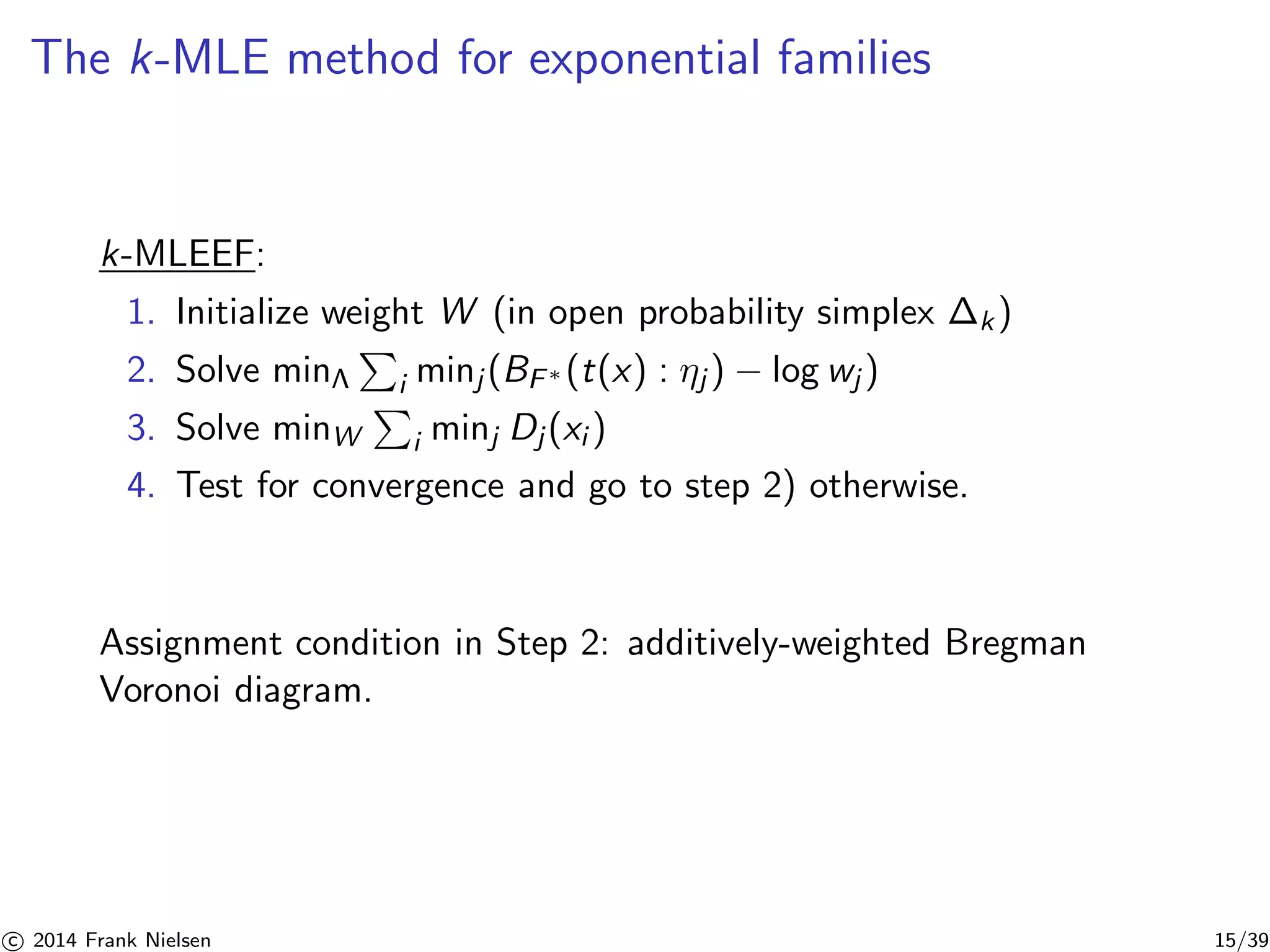
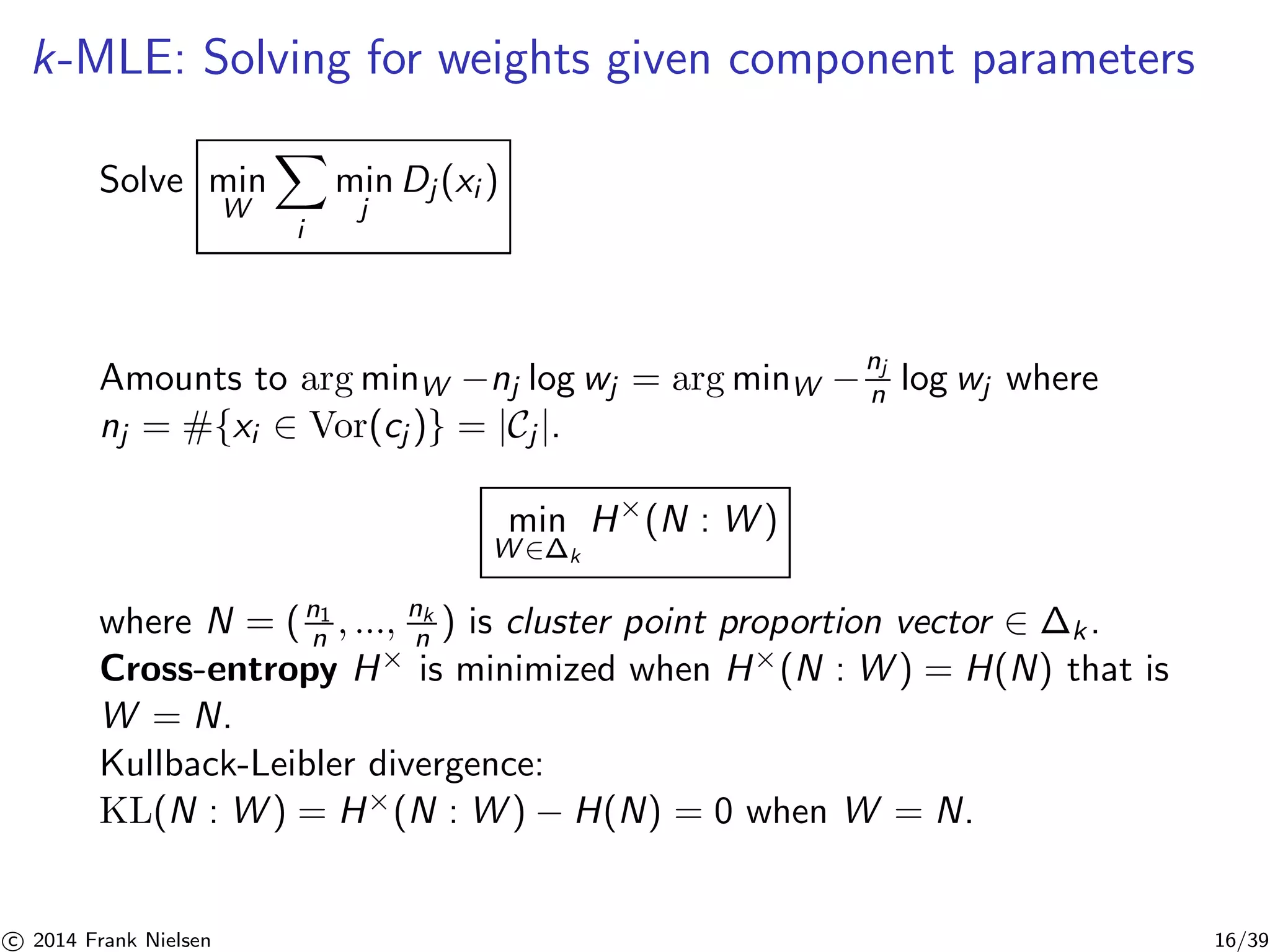
![MLE for exponential families
Given a ML farthest Voronoi partition, computes MLEs θj ’s:
ˆθj = argmax
∈Θ
Y
xi∈Vor(cj )
pF (xi ; θ)
is unique (***) maximum since ∇2F(θ) ≻ 0:
Moment equation : ∇F(ˆθj ) = η(ˆθj ) =
1
nj
X
xi∈Vor(cj )
t(xi ) = ¯t = ˆη
MLE is consistent, efficient with asymptotic normal distribution:
ˆθj ∼ N
θj ,
1
nj
I−1(θj )
Fisher information matrix
I (θj ) = var[t(X)] = ∇2F(θj ) = (∇2F∗)−1(ηj )
MLE may be biased (eg, normal distributions).
c 2014 Frank Nielsen 17/39](https://image.slidesharecdn.com/slides-kmle-maxent2014-140917112600-phpapp02/75/On-learning-statistical-mixtures-maximizing-the-complete-likelihood-17-2048.jpg)
![Existence of MLEs for exponential families (***)
For minimal and full EFs, MLE guaranteed to exist [3, 21] provided
that matrix:
T =
1 t1(x1) ... tD(x1)
...
... ...
...
1 t1(xn) ... tD(xn)
(1)
of dimension n × (D + 1) has rank D + 1 [3].
For example, problems for MLEs of MVNs with n d observations
(undefined with likelihood ∞).
Condition: ¯t = 1
nj
P
xi∈Vor(cj ) t(xi ) ∈ int(C), where C is closed
convex support.
c 2014 Frank Nielsen 18/39](https://image.slidesharecdn.com/slides-kmle-maxent2014-140917112600-phpapp02/75/On-learning-statistical-mixtures-maximizing-the-complete-likelihood-18-2048.jpg)

![The k-MLE method: Heuristics based on k-means
k-means is NP-hard (non-convex optimization) when d 1 and
k 1 and solved exactly using dynamic programming [26] in
O(n2k) and O(n) memory when d = 1.
Heuristics:
◮ Kanungo et al. [18] swap: yields a (9 + ǫ)-approximation
◮ Global seeds: random seed (Forgy [12]), k-means++ [2],
global k-means initialization [38],
◮ Local refinements: Lloyd batched update [19], MacQueen
iterative update [20], Hartigan single-point swap [16], etc.
◮ etc.
c 2014 Frank Nielsen 20/39](https://image.slidesharecdn.com/slides-kmle-maxent2014-140917112600-phpapp02/75/On-learning-statistical-mixtures-maximizing-the-complete-likelihood-20-2048.jpg)
![Generalized k-MLE
Weibull or generalized Gaussians are parametric families of
exponential families [35]: F(γ).
Fixing some parameters yields nested families of (sub)-exponential
families [34]: obtain one free parameter with convex conjugate F∗
approximated by line search (Gamma distributions/generalized
Gaussians).
c 2014 Frank Nielsen 21/39](https://image.slidesharecdn.com/slides-kmle-maxent2014-140917112600-phpapp02/75/On-learning-statistical-mixtures-maximizing-the-complete-likelihood-21-2048.jpg)
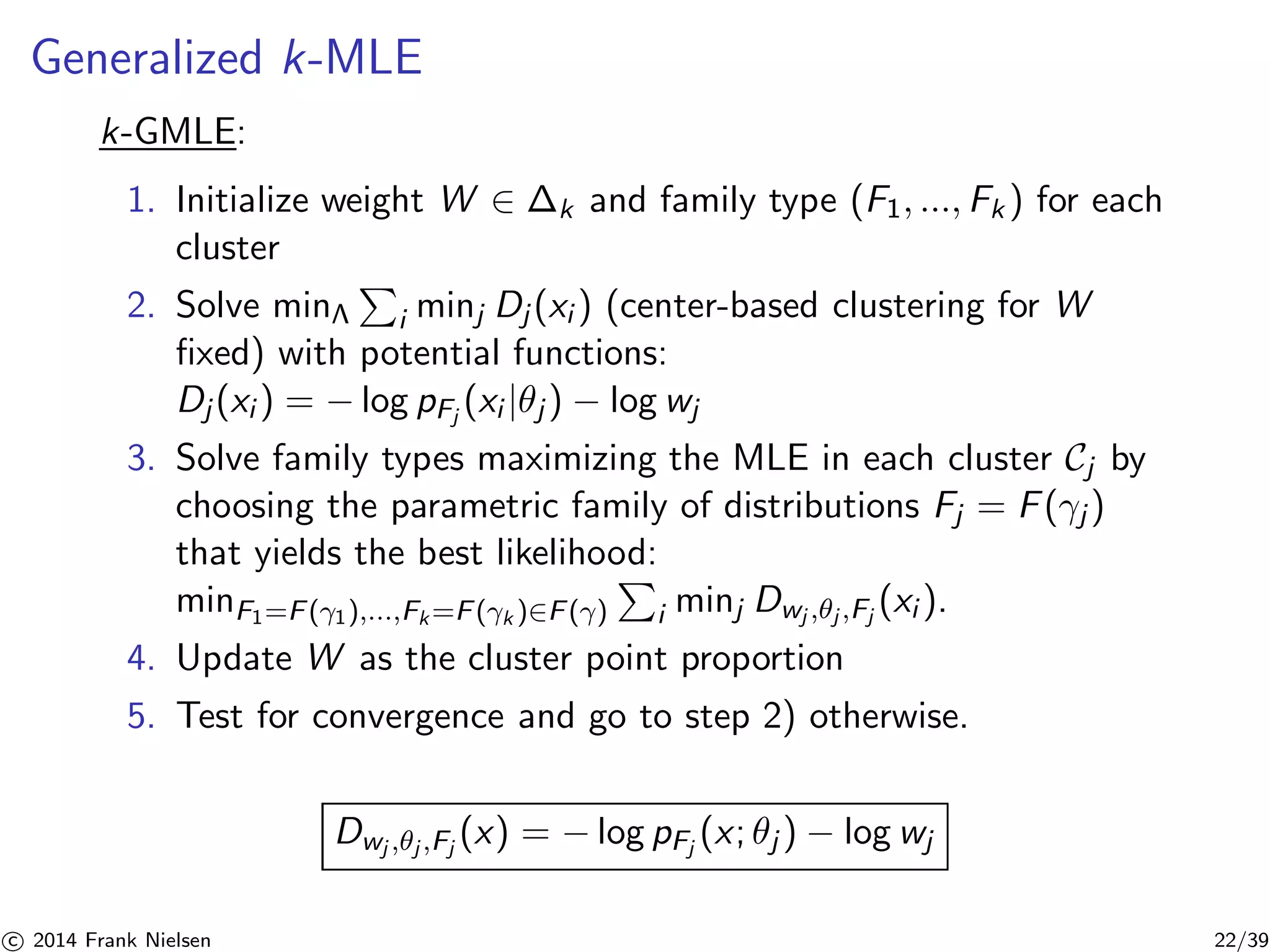
![Generalized k-MLE: Convergence
◮ Lloyd’s batched generalized k-MLE maximizes monotonically
the complete likelihood
◮ Hartigan single-point relocation generalized k-MLE maximizes
monotonically the complete likelihood [32], improves over
Lloyd local maxima, and avoids the problem of the existence
of MLE inside clusters by ensuring nj ≥ D in general position
(T rank D + 1).
◮ Model selection: Learn k automatically using DP
k-means [32] (Dirichlet Process)
c 2014 Frank Nielsen 23/39](https://image.slidesharecdn.com/slides-kmle-maxent2014-140917112600-phpapp02/75/On-learning-statistical-mixtures-maximizing-the-complete-likelihood-23-2048.jpg)
![k-MLE [23] versus EM for Exponential Families [1]
k-MLE/Hard EM [23] (2012-) Soft EM [1] (1977)
= Bregman hard clustering = Bregman soft clustering
Memory lighter O(n) heavier O(nk)
Assignment NNs with VP-trees [27], BB-trees [30] all k-NNs
Conv. always finitely ∞, need stopping criterion
Many (probabilistically) guaranteed initialization for
k-MLE [18, 2, 28]
c 2014 Frank Nielsen 24/39](https://image.slidesharecdn.com/slides-kmle-maxent2014-140917112600-phpapp02/75/On-learning-statistical-mixtures-maximizing-the-complete-likelihood-24-2048.jpg)
![k-MLE: Solving for D = 1 exponential families
◮ Rayleigh, Poisson or (nested) univariate normal with constant
σ are order 1 EFs (D = 1).
◮ Clustering problem: Dual 1D Bregman clustering [1] on 1D
scalars yi = t(xi ).
◮ FML Voronoi diagrams have connected cells: Optimal
clustering yields interval clustering.
◮ 1D k-means (with additive weights) can be solved exactly
using dynamic programming in O(n2k) time [26]. Then
update the weights W (cluster point proportion) and
reiterate...
c 2014 Frank Nielsen 25/39](https://image.slidesharecdn.com/slides-kmle-maxent2014-140917112600-phpapp02/75/On-learning-statistical-mixtures-maximizing-the-complete-likelihood-25-2048.jpg)
![Dynamic programming for D = 1-order mixtures [26]
Consider W fixed. k-MLE cost:
Pk
j=1 l (Cj ) where Cj are clusters.
x1 xj−1 xj xn
MLEk−1(X1,j−1) MLE1(Xj,n)
ˆ
k = ˆ
j,n
Dynamic programming optimality equation:
MLEk (x1, ..., xn) =
n
max
j=2
(MLEk−1(X1,j−1) +MLE1(Xj ,n))
Xl ,r : {xl , xl+1, ..., xr−1, xr }.
◮ Build dynamic programming table from l = 1 to l = k
columns, m = 1 to m = n rows.
◮ Retrieve Cj from DP table by backtracking on the argmaxj .
◮ For D = 1 EFs, O(n2k) time [26].
c 2014 Frank Nielsen 26/39](https://image.slidesharecdn.com/slides-kmle-maxent2014-140917112600-phpapp02/75/On-learning-statistical-mixtures-maximizing-the-complete-likelihood-26-2048.jpg)
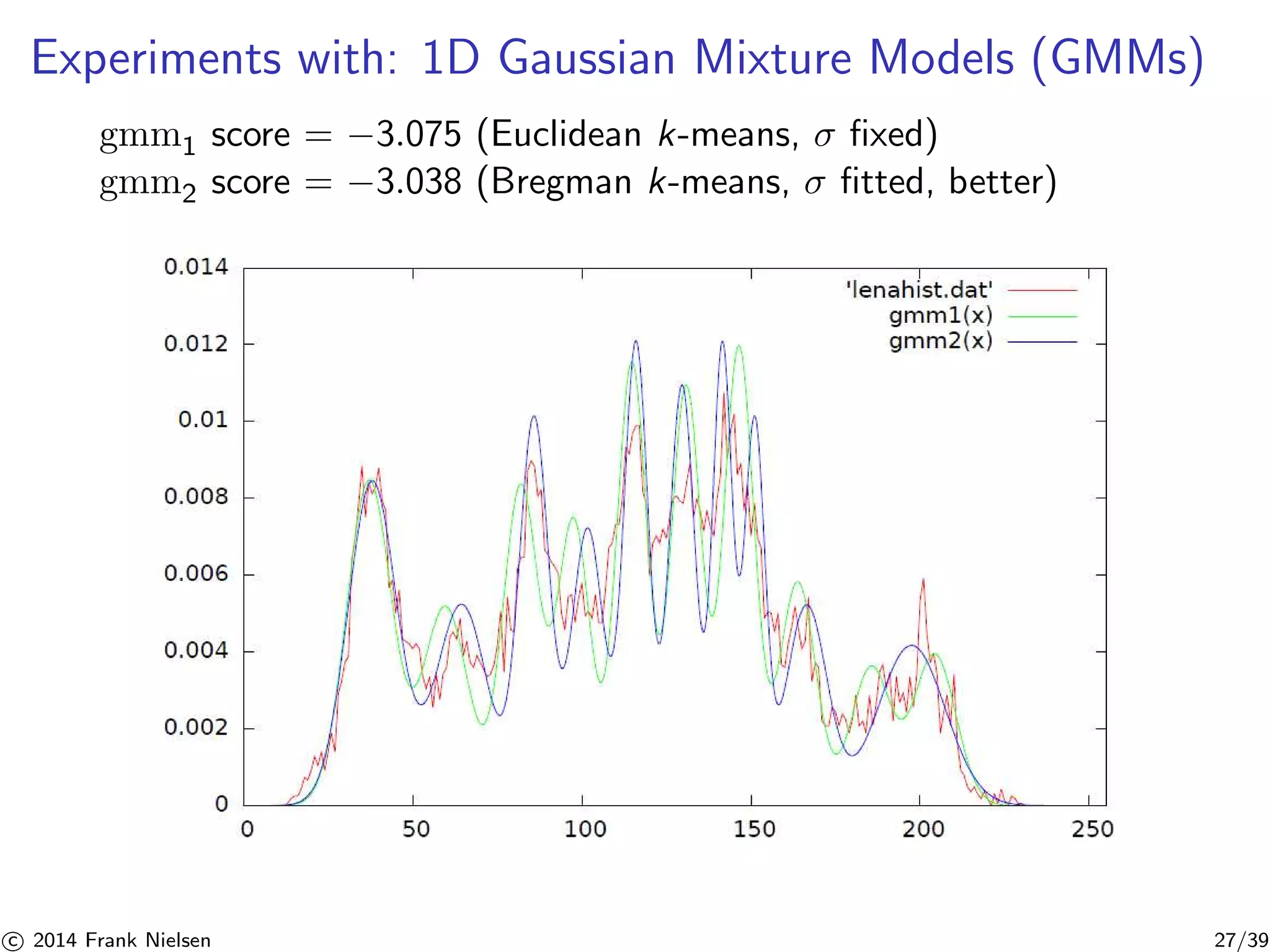
![Summary: k-MLE methodology for learning mixtures
Learn MMs from sequences of geometric hard clustering [11].
◮ Hard k-MLE (≡ dual Bregman hard clustering for EFs) versus
soft EM (≡ soft Bregman clustering [1] for EFs):
◮ k-MLE maximizes the complete likelihood lc .
◮ EM maximizes locally the incomplete likelihood li .
◮ The component parameters η geometric clustering (Step 2.)
can be implemented using any Bregman k-means heuristic on
conjugate F∗
◮ Consider generalized k-MLE when F∗ not available in closed
form: nested exponential families (eg., Gamma)
◮ Initialization can be performed using k-means initialization:
k-MLE++, etc.
◮ Exact solution with dynamic programming for order 1 EFs
(with prescribed weight proportion W).
◮ Avoid unbounded likelihood (eg., ∞ for location-scale
member with σ → 0: Dirac) using Hartigan’s heuristic [32]
c 2014 Frank Nielsen 28/39](https://image.slidesharecdn.com/slides-kmle-maxent2014-140917112600-phpapp02/75/On-learning-statistical-mixtures-maximizing-the-complete-likelihood-28-2048.jpg)
![Discussion: Learning statistical models FAST!
◮ (EF) Mixture Models allow one to approximate universally
smooth densities
◮ A single (multimodal) EF can approximate any smooth
density too [7] but F not in closed-form
◮ Which criterion to maximize is best/realistic: incomplete or
complete, or parameter distortions? Leverage many recent
results on k-means clustering to learning mixture models.
◮ Alternative approach: Simplifying mixtures from kernel density
estimators (KDEs) is one fine-to-coarse solution [33]
◮ Open problem: How to constrain the MMs to have a
prescribed number of modes/antimodes?
c 2014 Frank Nielsen 29/39](https://image.slidesharecdn.com/slides-kmle-maxent2014-140917112600-phpapp02/75/On-learning-statistical-mixtures-maximizing-the-complete-likelihood-29-2048.jpg)
![Thank you.
Experiments and performance evaluations on generalized k-MLE:
◮ k-GMLE for generalized Gaussians [35]
◮ k-GMLE for Gamma distributions [34]
◮ k-GMLE for singly-parametric distributions [26]
(compared with Expectation-Maximization [8])
Frank Nielsen (5793b870).
c 2014 Frank Nielsen 30/39](https://image.slidesharecdn.com/slides-kmle-maxent2014-140917112600-phpapp02/75/On-learning-statistical-mixtures-maximizing-the-complete-likelihood-30-2048.jpg)

